Speaking proposal
13-14.06.2023
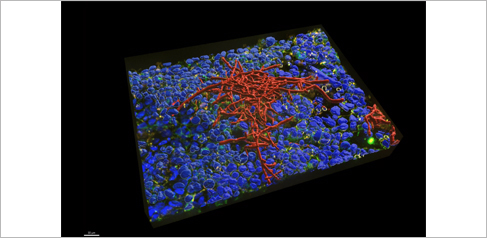
Gut-on-chip model for image-based analysis of Candida albicans infection
Leibniz Institute for Natural Product Research and Infection Biology – Hans Knöll Institute / GERMANY
Microbial dysbiosis in the gut and immune system dysfunctions are often associated with the pathogenesis of opportunistic infections, chronic inflammation, and inflammatory bowel disease. The gut-on-chip model is a powerful tool to effectively investigate underlying host-pathogen interactions in a complex in vivo-like environment. To exploit the full potential of the chip, we developed an automated image analysis pipeline to analyse infections with the pathogenic yeast Candida albicans in this model. The pipeline provides three-dimensional morphological characterization of fungal microcolonies, quantification of the epithelial tissue architecture and the microcolony invasion into the endothelial compartment. The combination of the gut-on-chip model and automated image analysis facilitates quantitative studies of infection scenarios and the dissection of the role of fungal and host factors.

Clinical application of physical characterization of major blood cell types during COVID-19 and beyond facilitating microfluidics
Max Planck Institute for the Science of Light & Max-Planck-Zentrum für Physik und Medizin / GERMANY
Research over the last decades revealed single-cell physical properties as label-free markers of cell state and function. Microfluidic techniques assessing those properties in high-throughput make the transition of research knowledge to clinical application possible, as we´ll present. Facilitating deformability cytometry on the example of blood measurements from severely ill COVID-19 patients and comparing them to recovered individuals and healthy controls, we found changes in the physical properties of all leucocytes, indicative for an overall activated immune status. In addition, found changes in the deformation of red blood cells are potentially critical for circulation. Some changes persisted months after the infection presenting a possible causal link of altered blood mechanics and the persistent symptoms in Post-Covid.

How to choose the right fomulation for microfluidic applications?
EMULSEO / FRANCE
Droplet-based microfluidics has emerged as an efficient solution for rapid, precise, quantitative and low-cost screening tool for biological and chemical applications. A common issue in droplet-based microfluidic experiments involving the use of dyes is dye leakage. The dye release into the oil phase and neighboring droplets results in a decrease of the accuracy of fluorescence monitoring. The parameters influencing the dye retention in droplets are the nature of the buffer or cell culture medium, the choice of fluorophore and its hydrophilicity, the oil phase and the concentration, nature and molecular weight of the surfactant. In this presentation, we will first present a comprehensive investigation of the impact of oil choice and surfactant concentration on dye leakage during droplet-based microfluidic experiments. The performance of two fluorinated oils and surfactant concentrations on dye retention will be discussed. Secondly, theimpact on the results resolution of the surfactant auto-fluorescence will be discussed.

Surface Modification of Smart Sensors & Microfluidics for Life Sciences
AIT Austrian Institute of Technology GmbH / AUSTRIA
There is an increasing demand for point-of-care (POC) systems for healthcare and lifestyle applications due to their availability, low-cost fabrication, and ease of use. Crucial for these systems are stable biosensor functionalization layers for sample preparation or signal generation. For intermediate upscaling and batch fabrication, inkjet printable (bio)inks need to be developed and printing/spotting processes need to be established for reproducible modification of sensor surfaces. In this presentation, we will address these aspects by reviewing results from three different research projects, namely the Greensense (H2020, No 76100), ELSAH (H2020, No 825549) and the Hydrochip2 project (FFG._Nr. 883914) to give an overview of modern techniques for functionalizing POC biosensor systems, which is one of the most important steps towards commercialization.

Microscale resonators for microfluidic based Nuclear Magnetic Resonance spectroscopy
Leibniz Institute for Solid State and Materials Research (IFW) Dresden / GERMANY
Recent efforts in the down scaling of Nuclear Magnetic Resonance (NMR) spectroscopy has been focused on miniaturizing the core of this system to microscale detectors. This accomplishment ushers a new era for NMR spectroscopy in biological and medical studies, where the sample size can be in the range of micro- or nanoliters (nL), characteristic of microorganisms and cell cultures. Our novel 3D microscale resonator provides exceptional sensitivity and spectral resolution (8ppb) for analyte quantities as small as 1.5nL, among of the smallest known detection volumes in this field. The integrated epoxy microfluidic system further enhances the device's filling factor, bringing it close to 100%. The microfluidic system is cost-efficient, rigid, transparent, and compatible with commercial connectors.
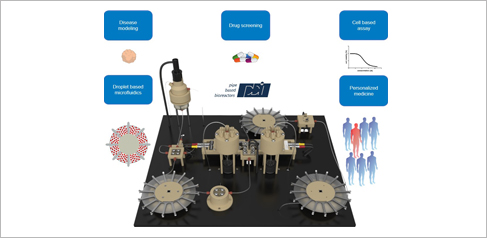
High-precision droplet based microfluidic platform for drug screening validation using an AlamarBlue assay
Institute for Bioprocessing and Analytical Measurement Techniques e.V. / GERMANY
Cancer diseases are still one of the most reason for deaths worldwide because in some cases there is no successful therapy available. The high-throughput character of droplet based microfluidics open up a chance to verify the influence of drugs to such diseases. Our approach allows the validation of IC50-degrees with a very high resolution, here using the AlamarBlue assay. With our modular platform the formation and cultivation of spheroids from adherent cell suspensions permits to mimic the in vivo situation better compared to monolayers of cell suspensions. Combining the advantages, we will get in progress in the fight against different diseases. Furthermore, because of the modular character of the platform, different biological, medical and chemical applications can be addressed.

Microcontact Printing coupled with Organotypic Brain Slice Cultures
Medical University of Innsbruck - Psychiatry I / AUSTRIA
In the three-dimensional, 150 µm–thick organotypic brain slice, all complex cellular connections are preserved, which allows us to perform the ex vivo–culturing of brain cells for many weeks. We connect these brain slices to microcontact prints, to develop a simple brain-on-a-chip model. Microcontact printing enables us to apply peptides or proteins of our choice in a pattern, with µm precision. We are currently able to direct not only nerve fibers and brain vessels, but also microglia—the immune cells of the brain—along such microcontact prints. Such a brain-on-a-chip model could make it possible to construct a miniature brain, develop new drugs, and develop a diagnostic method for neurodegenerative diseases.

NIR-fluorescent biosensors for the early detection of pathogens
Fraunhofer Institute for Microelectronic Circuits and Systems IMS / GERMANY
There is an increasing demand for early diagnostics of infections. It should be precise, sensitive and fast. Carbon nanotubes (CNT) used as fluorescent biosensors meet these requirements. Pathogen biochemical signals are sensed via the functionalized surface of the CNT and subsequently transduced into optical signals (near infrared fluorescence changes). By multiplexing with distinct functionalized sensors, the specificity to distinguish pathogens is enhanced. This approach is further developed into a pathogen sensing platform that is easily adaptable by tailoring the functionalization and constructing new sensor arrays. It is possible to utilize this in a Point-of-Care setting or as a sensor patch on medical instruments or implants.

A multifunctional OSTE+ polymer microfluidic tumor spheroid chip
University of Jan Evangelista Purkynje in Ústí nad Labem / CZECH REPUBLIC
Tumor spheroids present a more accurate model of in vivo tumors compared to standard 2D cell cultures. One of the promising methods for creating tumor spheroids is the droplet microfluidics. We are developing a multifunctional droplet-based microfluidic system, fabricated from off-stoichiometry thiol-ene epoxy (OSTE+) polymer, for generation and cultivation of tumor spheroids. Our chip presents a lab-on-chip solution for generation and cultivation of tumor spheroids and aims to overcome the disadvantage of droplet-based systems for these purposes, which is a limited lifespan of the formed spheroids in the droplets because of difficult medium renewal.
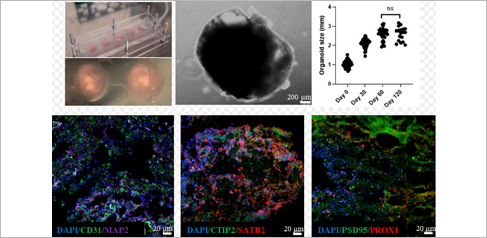
Enhanced cerebral organoid maturation in the microfluidic platform
EGE University / TURKEY
Cerebral organoids mimics the characteristics of the human brain and have lately become the focus of neurological diseases. Dynamic techniques have been utilized to assess the maturation of cerebral organoids derived from iPSCs. Novel microfluidic platform offers excellent reproducibility, morphological similarity with high harvestability of cerebral organoids. Low shear stress in the microfluidic platform not only supported cerebral organoid formation by simulating the hemodynamic forces as in the neurodevelopmental process, but also boosted survival by enhancing oxygen and nutrient transport. Laminar flow induced the development of various brain regions and improved neuronal and endothelial cell diversity, as well as functional neuronal cell activity. The novel microfluidic platform emerges as a reliable preclinical tool for evaluating new therapies against neurological diseases.
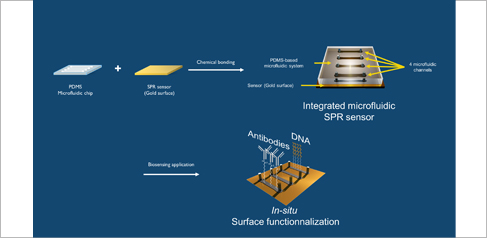
Development of integrated leak-free microfluidic Surface Plasmon Resonance sensors towards Chemical & Biosensing application
Centrale Lille / FRANCE
Up to date, Surface Plasmon Resonance (SPR) analyses are generally carried out by introducing the plasmonic sensor chips into the reading equipment that includes a microfluidic system that usually works by physical clamping, which facilitates the supply of the sensor with ad-hoc solutions. In this work, we present the integration of microfluidic on top of the SPR sensors through a one-step chemical functionalization process using thiolated silane (3-MercaptoPropyl TriMethoySilane (MPTMS)) allowing binding between the microfluidic chip made of a polymer (PDMS) and the plasmonic sensors gold layer. Microfluidic sensors were characterized by contact angle measurements, ATR-FTIR. The developped binding process was compared with the well-known plasma-corona treatments by mechanical and plasmonic tests.

Lipopolysaccharides: A practical guide to complex microarrays development
Functional Genomics Center Zurich / ETH Zurich / University of Zurich / SWITZERLAND
Lipopolysaccharides (LPS) are bacterial toxins consisting of a lipid and a carbohydrate part that are presented at the bacterial surface. Immobilization of LPS on a microarray surface enables to conduct clinical studies of body fluids in order to identify antibodies created by the immune system follwing an infection with the respective bacterium. The development of an LPS microarray is a challenge particularly since applicable data from literature are scarcely available. Using LPS as example for difficult and complex probes I will present a universal workflow for microarray development. This will outline a step-by-step process to identify relevant spotting and processing parameters in order to obtain optimal probe immobilization, spot morphology, and signal-to-noise ratio.

Approaches on a Fully Integrated sub-THz Microfluidic Sensor Platform in a SiGe BiCMOS Process Environment: Technology, Circuits, Systems
Ulm University / Leibniz Institute for High Performance Microelectronics / GERMANY
The functionalization of frequencies in sub-THz regime is basically motivated by the existence of vibrational and rotational transition energy levels in biological cells and bio-molecules and is further accelerated with the rapid development of silicon and biomedical technologies. The main motivation of our recent work has been lying in the seamless portation of microfluidics with its extensive and even growing analysis capabilities to an advanced silicon-based technology environment, enabling the implementation of highly miniaturized sensors and broadband readout circuits in closest proximity, freeing up innovative concepts on electronic and fluidic system level. The highly promising candidate for the realization of SiGe-compatible microfluidic channels is the utilization of copper pillar technology for sidewall fabrication, which has been reported and demonstrated recently.
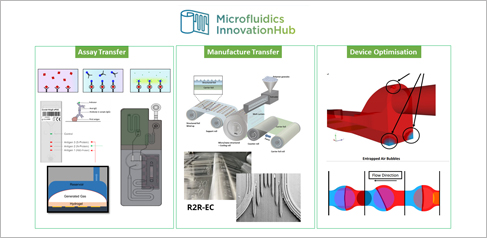
The Microfluidics Innovation Hub: typical service entry points towards the development of innovative microfluidic products.
Microfluidics Innovation Hub / AUSTRIA
The microfluidics Innovation Hub is a single-entry point towards multiple services offered by the NextGenMicrofluidics EU Horizon 2020 consortium, along the value chain of developing microfluidic products. Here, we showcase our technologies in the context of typical service entry points. One typical entry point is assay transfer, for which we showcase the transfer of immunoassays for clinical and food safety purposes onto point-of-care microfluidic platforms incorporating microfluidic control and readout. We also perform manufacture transfer towards the industrialisation of microfluidic components using high-specification injection-moulding and roll-to-roll manufacture, including CFD-assisted design and surface modification. Finally, we demonstrate our ability to optimise customer microfluidic products, for example in developing CFD-assisted localised surface modification strategies to solve flow challenges including bubble formation.

Breakthrough nervous system-on-chip technology to model neurodegenerative diseases
Eindhoven University of Technology (CONNECT project) / THE NETHERLANDS
Within the European CONNECT project, Eindhoven University of Technology (TU/e) develops a nervous system-on-chip (NoC) for drug screening for neurodegenerative diseases. By employing TU/e’s proprietary microsieve read-out technology the validity of such in vitro models can be improved. Our NoC system is engineered to combine human-derived brain cells with in vivo-like environments to provide reductionist models that are easy to handle in your pharmaceutical workflow. Furthermore, our technology comprises a substrate with microfluidically addressed 3D cell capture sites arranged in an arrayed configuration advancing statistical outcomes. Complementing these microsieve capture sites with electrodes results in a microSieve Electrode Array arrangement, thereby contributing to process automation and providing a faster translation of biomedical research into new therapies.

Microfluidic solutions for biomedical research
ELVESYS SAS / FRANCE
Elvesys is a company that specializes in developing advanced instruments for microfluidic cell culture. Our products are designed to provide researchers with precise and versatile tools to create complex microenvironments and perform high-throughput experiments. This offers new opportunities for disease modeling, drug screening, and personalized medicine. The instruments provide researchers with powerful tools to investigate cellular behavior, disease mechanisms, and drug development. Elvesys participates in collaborative research projects and will present 3 projects that revolve around microfluidic cell culture and organ-on-chip technology, and the developments on the microfluidic instruments that we are currently performing in order to advance the state-of-the art. A special focus is placed on user-friendly systems, custom approaches and miniaturization, all in the field of biomedical research.
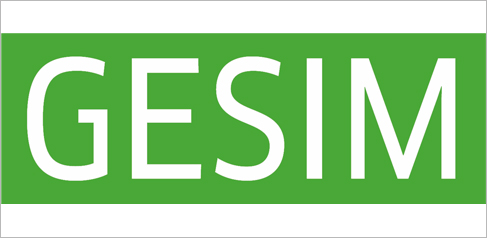
Tools for bioprinting, micrometer patterning and nanolitre pipetting – flexibility for biochips and tissue engineering
GESIM mbH / GERMANY
GeSiM Picolitre pipetting instruments are useful companions for development and production of diagnostic test kits. Featuring unique piezoelectric pipets, droplet deposition of varying samples on biosensors, biochips, NC-membranes and 96-well plates becomes easy and reliable. By the combination with full 3D-printing on the same instrument, manufacturing of microfluidic patterns/ devices and reagent deposition can be synchronized. This single-step procedure allows quick design optimization of your microfluidic experiment for enhanced performance. An unrivalled range of extruders for even high-viscous polymers enables a wide range of printable polymers. By use of bioinks, combination of Picolitre pipetting and 3D-printing of cell-laden scaffold opens up new ways in regenerative medicine.